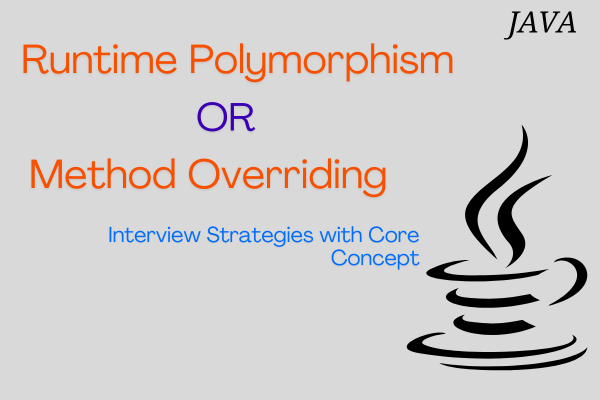Runtime polymorphism in Java, often referred to as dynamic method dispatch or method overriding, is a key feature of Java’s object-oriented programming that enables methods to be resolved during runtime rather than compile time. This capability allows developers to write more flexible and reusable code and promotes the principles of abstraction and encapsulation. Runtime polymorphism in Java uses late binding, meaning that the type of the object is determined at runtime rather than at compile-time.
Table of Contents
Concept Overview
In Java, runtime polymorphism is primarily achieved through two mechanisms: inheritance and method overriding. When a subclass redefines a method from its superclass, the version of the method that gets executed is determined by the object that the reference points to at runtime.
Key Characteristics
- Inheritance: This is the foundation of polymorphism, allowing a subclass to inherit methods and properties from a parent class.
- Method Overriding: This occurs when a subclass provides a specific implementation of a method already defined in its superclass. The method in the subclass must have the same signature (name, return type, and parameters) as in the superclass.
- Dynamic Binding: The decision about which method to invoke is made at runtime based on the actual object type, not the reference type.
References and Objects in Runtime Polymorphism
Understanding the distinction between reference variables and object instances is crucial for grasping runtime polymorphism.
- A reference variable is a pointer to an object in memory. It determines what type of object can be assigned to it. For instance, if you have a superclass named Bank and subclasses like ICICI and HDFC, you can declare a reference variable of type Bank to hold instances of these subclasses.
- An object instance is the actual entity created in memory. The reference variable can point to any object of type Bank or its subclasses. The Java Virtual Machine (JVM) determines the method to invoke based on the actual object type that the reference points to, rather than the type of the reference itself.
Example Implementation:
To illustrate runtime polymorphism in Java, consider the following example involving a base class and two derived classes:
class Bank {
void show() {
System.out.println("Inside Bank...");
}
}
class ICICI extends Bank {
@Override
void show() {
System.out.println("Inside ICICI...");
}
}
class HDFC extends Bank {
@Override
void show() {
System.out.println("Inside HDFC...");
}
}
public class PolymorphismExample {
public static void main(String[] args) {
Bank myBank;
myBank = new ICICI(); // ICICI object
myBank.show(); // Output: Inside ICICI...
myBank = new HDFC(); // HDFC object
myBank.show(); // Output: Inside HDFC...
/* Note: The below code does not fall under runtime polymorphism in java since we are creating an object directly for the Bank class. */
myBank = new Bank(); // Bank Object
myBank.show(); // Inside Bank...
}
}In the example:-
– The Bank class has a method show().
– The ICICI and HDFC classes override the show() method with their specific implementations.
– In the main method, a reference of type show can point to objects of both ICICI and HDFC.
– When show() is called, the actual method invoked depends on the object type (ICICI or HDFC), showcasing runtime polymorphism in Java.
– Finally, when we create a Bank class object and call its show method, the output reflects the behavior defined in the Bank class.
Benefits of Runtime Polymorphism in Java
- Code Reusability: It allows for writing general code that can work with different subclasses without needing modifications.
- Flexibility: Programs can be more easily extended or modified, as new subclasses can be added with minimal changes to existing code.
- Maintainability: By adhering to a clear structure of abstraction, code maintenance becomes simpler and more organized.
Conclusion:
Runtime polymorphism is a powerful feature in Java that enhances the language’s capability to handle complex systems. By enabling dynamic method dispatch through method overriding, it promotes a design where objects can be treated as their parent types while still executing the specific behaviors of their actual types. This leads to more adaptable and maintainable code, making it a vital concept for any Java developer to master.
Interview Tips:
Interviewers often test your understanding of runtime polymorphism without directly using that term. Instead, they may refer to dynamic method dispatch or method overriding, both of which are synonyms for runtime polymorphism. They might also ask about late binding in Java, as it’s a key concept related to this topic.
When explaining runtime polymorphism in Java, always support your answer with a well-structured code example. It’s essential to clarify the relationship between the reference variable and the object instance to fully demonstrate how runtime polymorphism works in Java.


1 thought on “Mastering Runtime Polymorphism in Java: Core Concepts and Interview Success”